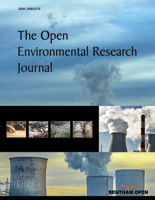
The Open Environmental Research Journal
ISSN: 2590-2776 ― Volume 16, 2023
- New Journal Website
- Journal Home
- Editorial Board
- Board Recruitment Workflow
- Instructions for Authors
- Plagiarism Prevention
- Fabricating and Stating False Information
- Research Misconduct
- Post Publication Discussions and Corrections
- Allegations from Whistleblowers
- Advertising Policy
- Short Guide
- Editorial Policies
- Publishing Ethics and Rectitude
- Quick Track Option
- Reviewer Guidelines
- Guidelines for Guest Editors
- Publication Fee
- Publication Cycle - Process Flowchart
- Archiving Policies
- Special Issues
Temporal Variation in Abundance and Distribution of Butterflies in a Southern Nigerian National Park
Chioma C. Ojianwuna1, *, Polycarp A. Umoru2Abstract
Aims:
The aim of this study was to determine the butterfly diversity in Okomu National Park, Nigeria in order to make available information on butterfly species in this protected areas.
Background:
Butterflies are a taxonomically important group for predicting the health of the environment.
Objective:
In order to establish butterfly abundance and distribution in Okomu National Park, a temporal variation study was conducted for a period of twenty-four months (July 2012 to June 2014).
Methods:
Eight transects (Disturbed habitat (DIS), Forest Edge/Plantation (FE/P), Moderately Open Forest (MOF), Forest Along Road/Moist Patches (FAR/MP), Riparian Habitat (RIP), Closed Canopy (CC), Shrub (SHR) and Grassland (GRA) were mapped out from the four ranges (Igwonwan, Arakhuan, Julius Creek and Babui) from visual level of disturbance and degree of canopy closure for transect walk, butterfly net and baited trap methods of butterfly sampling. Environmental variables (temperature, relative humidity, and rainfall) were concurrently sampled with butterflies.
Results:
A total of 143 species and 6,310 individuals of butterflies were obtained from the families; Nymphalidae, Papilionidae, Pieridae, Lycaenidae, and Hesperiidae. Nymphalid (3103: 49.2%) and Pieridae (2269: 36.0%) predominated and Hesperiidae was recorded low (8: 0.1%). Significant differences were observed in the abundance of butterflies in the transects (p< 0.05). Rainfall was positively correlated with butterfly abundance. Butterfly abundance was higher in rainy season compared to dry season except in RIP where a reverse trend was observed. Abundance was higher in FAR/MP (1633: 25.9%) and MOF (1251: 19.8%) compared to other transects, and was lowest in SHR (295: 4.7%).
Conclusion:
It can be concluded that butterfly in Okomu forest is abundant and stable, and as such continuous effort is required to conserve butterfly flora and fauna in this park.
Article Information
Article History:
Electronic publication date: 26/12/2022Collection year: 2022
open-access license: This is an open access article distributed under the terms of the Creative Commons Attribution 4.0 International Public License (CC-BY 4.0), a copy of which is available at: https://creativecommons.org/licenses/by/4.0/legalcode. This license permits unrestricted use, distribution, and reproduction in any medium, provided the original author and source are credited.
* Address correspondence to this author at the Department of Animal and Environmental Biology, Faculty of Science, Delta State University, Abraka, Delta State, Nigeria; E-mail: ccojianwuna@gmail.com



